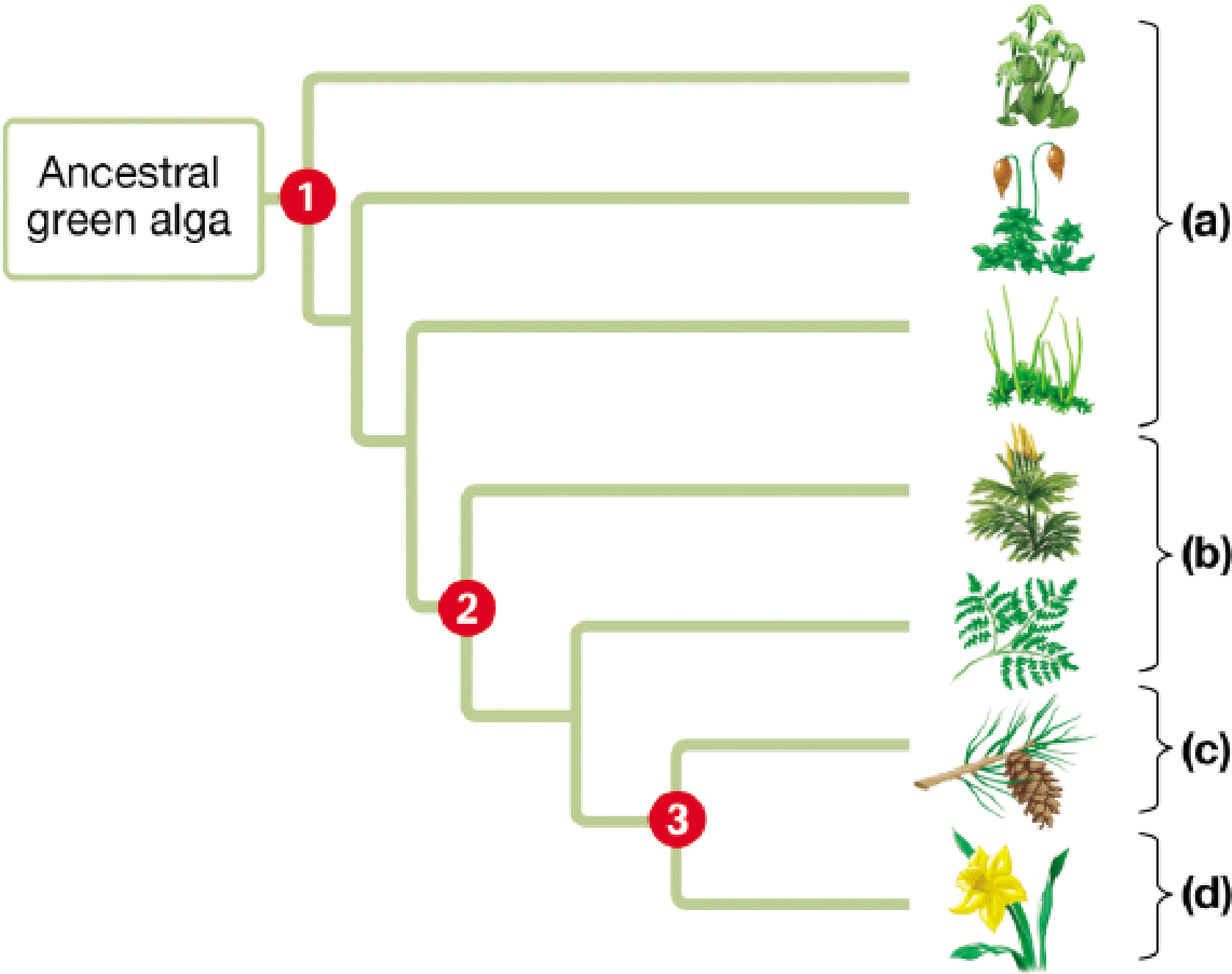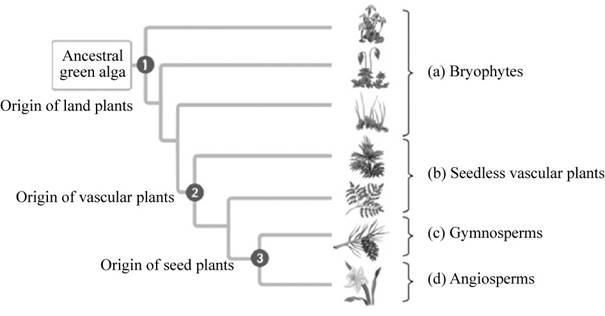
Concept explainers
In this abbreviated diagram, identify the four major plant groups and the key terrestrial adaptation associated with each of the three major branch points.

To determine: The four major plant group and their key terrestrial adaptation associated with each of the three major branch points.
Introduction:
The evolution of plants started with the origin of land plants that included the bryophytes. Land plants developed apical meristem and the embryos. After the land plants, the origin of vascular plants occurred. They involved the seedless fern and mosses. Lastly, the origin of seeded plants occurred. This includes the angiosperms and the gymnosperms.
Answer to Problem 1CC
Pictorial representation: The highlights of plant evolution are depicted in Fig.1.

Fig.1: The major events in plant evolution.
Explanation of Solution
The three distinct adaptations which gave rise to the four major plant groups are:
(1)
Correct answer: The origin of land plants.
Explanation:
The first terrestrial adaptation includes the origin of land plants. Their development included presence of the meristem and the embryos within the parent.
They include the major plant group (a) the bryophytes. The bryophytes are the non vascular plants and they evolved from the green algae about 475 million years ago. It included the development of apical meristem and embryos. For example: Mosses, hornworts, and liverworts. Hence, the correct answer is origin of land plants.
(2)
Correct answer: The origin of vascular plants.
Explanation:
The second adaptation includes the origin of vascular plants. It included the development of vascular tissues that helped the plants to grow tall and move away from the moist environment. They were now able to transport water to the leaves from the roots.
They include plant group (b) the seedless vascular plants. They evolved about 425 million years ago and include the ferns, club mosses and the horsetails. Hence, the correct answer is origin of vascular plants.
(3)
Correct answer: The origin of seed plants.
Explanation:
The third adaptation includes the origin of seed plants. They included the vascular seed plants. The seeds provided protection and dispersion of the embryos.
They include two major groups of plants:
Group (c) Gymnosperms: They include the seeded plants which have their seeds within the cones. They evolved about 360 million years ago. For example: pines, fir and spruce.
Group (d) Angiosperms: They include the vascular seeded plants that bear flowers. They evolved about 360 million years ago along with the gymnosperms. For example: rose, maple trees and oak trees. Hence, the correct answer is origin of seed plants.
Want to see more full solutions like this?
Chapter 17 Solutions
Campbell Biology: Concepts and Connections
- Price of visit Number of visits $700 0 $600 [1 $500 2 $400 3 $300 4 00000 The Table blow gives the demand curve for doctor visits for Elena. If the price of a doctor's visit is $600, and Elena does not have health insurance, she will visit the doctor times. If Elena obtains 50% coinsurance (the company pays 50% of the medical bill, Elena pays 50%), then Elena will visit the doctor times. 1; 2 0; 3 0; 2 1;4 2; 1arrow_forwardP 200 150- 100 50 w/instrance/ w/insurance 2 100 Demand Assume that the white curve (labeled "Demand") represents an individual's true demand for this particular health care service. The coinsurance associated with insurance option 1 (in blue) is likely _. 0000 100% 25% 50% 0%arrow_forwardUse the figure below. Bob and Nancy have the same income and total utility.. willingness to pay for an insurance premium will be lower than because they are. risk- averse. Total utility Current utility Bob's utility Nancy's utility 0000 Bob; Nancy; less Nancy; Bob; less Nancy; Bob; more Bob; Nancy; more Current Income incomearrow_forward
- Consider the figure below. Suppose the true price of a health care service is P1. Suppose further that the individual has obtained insurance that has a fixed copayment for this particular service. The copayment is represented by price P2. represents the quantity of the service the individual would consume without insurance. quantity of the service the individual would consume with the insurance. Health Care Service represents the P. P₂ a Q1;Q2 Q2; Q3 Q1; Q3 Q3; Q1 Q2; Q1 फ f Q ८ g d h Q3\D 7Q 00000arrow_forwardThe table shows the utility Jordan receives at various income levels, but they do not know what their income will be next year. There is a 15% chance their income will be $25,000, a 20% chance their income will be $35,000, and a 65% chance their income will be $45,000. We know that Jordan is Income $25,000 Utility 2,800 30,000 3,200 35,000 3,500 40,000 3,700 45,000 3,800 ☐ none of the above 0 000 risk taker (lover) because their marginal utility of income is increasing risk neutral because their marginal utility of income is constant risk averse because their marginal utility of income is decreasing risk neutral because their marginal utility of income is decreasingarrow_forwardOOOO a d+e d a+b+c Consider the figure below. Suppose the true price of a health care service is P1. Suppose further that the individual has obtained insurance that has a fixed copayment for this particular service. The copayment is represented by price P2. The social loss from moral hazard if the individual has copayment P2 is represented graphically by the area(s): Health Care Service P. a No 4 ८ e g Q2 Q3 Darrow_forward
- OOO O The table shows the utility Jordan receives at various income levels, but they do not know what their income will be next year. There is a 15% chance their income will be $25,000, a 20% chance their income will be $35,000, and a 65% chance their income will be $45,000. We know that Jordan's expected income is. Their utility from their expected income is_ Income $25,000 Utility 2,800 30,000 3,200 35,000 3,500 40,000 3,700 45,000 3,800 $45,000; 3,800 $40,000; 3,700 $25,000; 2,800 $35,000; 3,500 $30,000; 3,200arrow_forwardQuestion 1 Classify the Bird Mark 7; how is it: Powered Triggered Cycled Classify brid mark 7 Powered: By gas (oxygen) Triggered: Negative Pressure, caused by the patient’s inspiratory effort Cycled: The machine stops delivering gas and allows for exhalationarrow_forwardHypothetical "pedigree" for Sickle Cellarrow_forward
- would this be considered a novel protein and if not how can I fix it so it is and can you draw the corrections pleasearrow_forwardIn as much detail as possible, hand draw a schematic diagram of the hypothalamic-pituitary- gonad (HPG) axis in the human male. Be sure to include all the relevant structures and hormones. You must define all abbreviations the first time you use them. Please include (and explain) the feedback loops.arrow_forwardA negligence action was brought by a mother against a hospital on behalf of her minor daughter. It alleged that when the mother was 13 years of age, the hospital negligently transfused her with Rh-positive blood. The mother's Rh-negative blood was incompatible with and sensitized by the Rh-positive blood. The mother discovered her condition 8 years later during a routine blood screening ordered by her healthcare provider in the course of prenatal care. The resulting sensitization of the mother's blood allegedly caused damage to the fetus, resulting in physical defects and premature birth. Did a patient relationship with the transfusing hospital exist?arrow_forward
 Biology (MindTap Course List)BiologyISBN:9781337392938Author:Eldra Solomon, Charles Martin, Diana W. Martin, Linda R. BergPublisher:Cengage Learning
Biology (MindTap Course List)BiologyISBN:9781337392938Author:Eldra Solomon, Charles Martin, Diana W. Martin, Linda R. BergPublisher:Cengage Learning Concepts of BiologyBiologyISBN:9781938168116Author:Samantha Fowler, Rebecca Roush, James WisePublisher:OpenStax College
Concepts of BiologyBiologyISBN:9781938168116Author:Samantha Fowler, Rebecca Roush, James WisePublisher:OpenStax College Biology: The Dynamic Science (MindTap Course List)BiologyISBN:9781305389892Author:Peter J. Russell, Paul E. Hertz, Beverly McMillanPublisher:Cengage Learning
Biology: The Dynamic Science (MindTap Course List)BiologyISBN:9781305389892Author:Peter J. Russell, Paul E. Hertz, Beverly McMillanPublisher:Cengage Learning Biology 2eBiologyISBN:9781947172517Author:Matthew Douglas, Jung Choi, Mary Ann ClarkPublisher:OpenStax
Biology 2eBiologyISBN:9781947172517Author:Matthew Douglas, Jung Choi, Mary Ann ClarkPublisher:OpenStax





